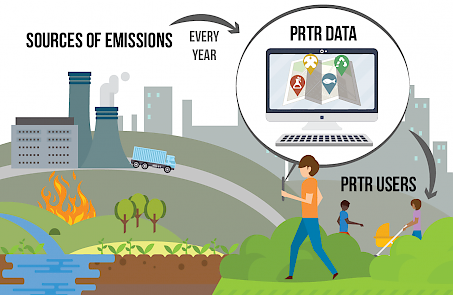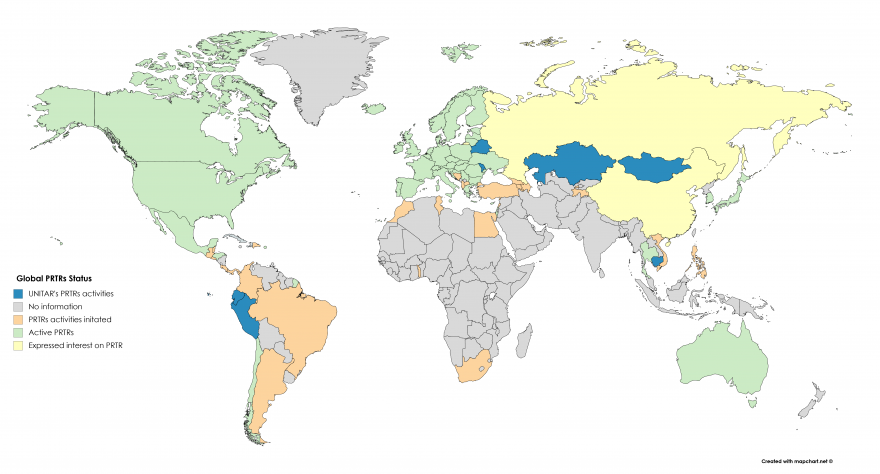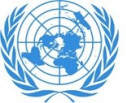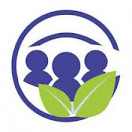- Do you know what is happening in your neighbourhood?
- Do nearby industrial facilities release toxic chemicals?
- What kinds of toxic chemicals are they releasing?
We all have the right to know about the chemicals we may be exposed to in our daily lives: a Pollutant Release and Transfer Register (PRTR) can help you find these answers!
Welcome to UNITAR’s PRTR Platform. UNITAR’s Chemical and Waste Management Programme is one of the leading agencies working on PRTRs at global level. Here, you can learn more about different aspect of PRTR, with our virtual classroom PRTR:Learn, as well as on-going projects and event related to PRTRs. A resource section is also available and provide a collection of international guidance on PRTRs as well as country-specific documents and strategies regarding a PRTRs’ implementations. And don’t forget to join a growing PRTR community on the social networks, to share experience and learn more about PRTRs.
So, what is a PRTR? PRTRs are systems that provide you with information on toxic substances emitted every year into air, water or land. PRTRs show on interactive maps the different sources of pollution, such as industries (point sources), agriculture and transportation (non-point sources).

Over the past few decades, PRTRs have emerged as a new tool in the field of chemicals management. It all started in the United States: following the tragic accident in Bhopal (India) in 1984, the United States Congress approved the Emergency Planning and Community Right to Know Act, establishing a register called the Toxics Release Inventory (TRI), which tracks releases to all media (air, water and land) and off-site transfers of more than 600 chemicals. Other countries, including Australia and Canada, followed shortly and developed their own national PRTR systems. This trend has been increasing globally ever since.
PRTRs are useful tools for chemicals management as they provide unprecedented and free public information on pollution releases to air, water and land. They enhance transparency and accountability of industry by providing geographic locations of facilities that release pollutants and act as incentive for finding innovative solutions that can reduce pollution and lead to sustainable increase in productivity. PRTRs also facilitate compliance with environmental standards and international agreements; and create a regular reporting of national data on emissions into the environment and transfers of hazardous waste.
The map below shows the status of PRTRs around the world:

The designations employed and the presentation of the material on this map do not imply the expression of any opinion whatsoever on the part of the Secretariat of the United Nations concerning the legal status of any country, territory, city or area or of its authorities, or concerning the delimitation of its frontiers or boundaries. Colors used are illustrative.
 The Kiev Protocol (entered into force in 2009), is the first legally binding international instrument on PRTRs. The Protocol assist countries to establish PRTRs that are publicly accessible and maintained through mandatory reporting of a wide range of harmful and potentially harmful substances from certain significant activities. The Protocol covers 64 activities and 86 substances and categories of substances.
The Kiev Protocol (entered into force in 2009), is the first legally binding international instrument on PRTRs. The Protocol assist countries to establish PRTRs that are publicly accessible and maintained through mandatory reporting of a wide range of harmful and potentially harmful substances from certain significant activities. The Protocol covers 64 activities and 86 substances and categories of substances.
 The Recommendation of the Council on Implementing Pollutant Release and Transfer Registers, from the OECD (adopted, in 1996 and revised in 2018), which encourages Adherents to design and establish PRTRs through a transparent and objective process. The aim is to foster international comparability of PRTR data by incorporating core elements such as triggers for reporting based on a harmonised list of pollutants and sectors. The OECD also promotes accessible data to the public in a timely and regular basis and in a user-friendly format such as through an electronic search tool; The organisation also advocates for the quality and timeliness of the data, as well as effectiveness of the PRTR.
The Recommendation of the Council on Implementing Pollutant Release and Transfer Registers, from the OECD (adopted, in 1996 and revised in 2018), which encourages Adherents to design and establish PRTRs through a transparent and objective process. The aim is to foster international comparability of PRTR data by incorporating core elements such as triggers for reporting based on a harmonised list of pollutants and sectors. The OECD also promotes accessible data to the public in a timely and regular basis and in a user-friendly format such as through an electronic search tool; The organisation also advocates for the quality and timeliness of the data, as well as effectiveness of the PRTR.
The United Nations Framework Convention on Climate Change (UNFCCC) requires Parties to establish national inventories of Greenhouse  Gases (GHGs) emissions and removals: updated inventories must be submitted annually by Annex I countries. Many of the substances covered by the Convention are usually included in a national PRTR.
Gases (GHGs) emissions and removals: updated inventories must be submitted annually by Annex I countries. Many of the substances covered by the Convention are usually included in a national PRTR.
 The Minamata Convention on Mercury (entered in force in August 2017) mentions PRTR as a mechanism that countries should give consideration to develop:” for the collection and dissemination of information on estimates of its annual quantities of mercury and mercury compounds that are emitted, released or disposed of through human activities” (Article 18). In addition, PRTRs support the importance of public information, awareness and education, and facilitating the exchange of information which are required in the Article 17 and 18.
The Minamata Convention on Mercury (entered in force in August 2017) mentions PRTR as a mechanism that countries should give consideration to develop:” for the collection and dissemination of information on estimates of its annual quantities of mercury and mercury compounds that are emitted, released or disposed of through human activities” (Article 18). In addition, PRTRs support the importance of public information, awareness and education, and facilitating the exchange of information which are required in the Article 17 and 18.
 The Stockholm Convention requires parties to estimate annual quantities of POPs released or disposed of, with the aim to protect human health and the environment from Persistent Organic Pollutants (POPs). Article 9 acknowledges PRTRs for the collection and dissemination of POPs releases exchange information. PRTR can also support other goals of the convention such as facilitate public information, awareness and education (Article 10), report to the Secretariat (Article 15) and periodically update implementation plans (Article 7) and undertake appropriate monitoring pertaining to POPs (Article 11).
The Stockholm Convention requires parties to estimate annual quantities of POPs released or disposed of, with the aim to protect human health and the environment from Persistent Organic Pollutants (POPs). Article 9 acknowledges PRTRs for the collection and dissemination of POPs releases exchange information. PRTR can also support other goals of the convention such as facilitate public information, awareness and education (Article 10), report to the Secretariat (Article 15) and periodically update implementation plans (Article 7) and undertake appropriate monitoring pertaining to POPs (Article 11).
 The Regional Agreement on Access to Information, Public Participation and Justice in Environmental Matters in Latin America and the Caribbean was adopted by 24 Latin American and Caribbean countries, in March 2018 and will enter into force in September 2018. This binding regional agreement aims to protect the rights of access to information, public participation and access to justice in environmental matters and encompass PRTRs in its Article 6 by stating that Article 6 states that "Each Party shall take steps to establish a pollutant release and transfer register covering air, water, soil and subsoil pollutants, as well as materials and waste in its jurisdiction. This register will be established progressively and updated periodically."
The Regional Agreement on Access to Information, Public Participation and Justice in Environmental Matters in Latin America and the Caribbean was adopted by 24 Latin American and Caribbean countries, in March 2018 and will enter into force in September 2018. This binding regional agreement aims to protect the rights of access to information, public participation and access to justice in environmental matters and encompass PRTRs in its Article 6 by stating that Article 6 states that "Each Party shall take steps to establish a pollutant release and transfer register covering air, water, soil and subsoil pollutants, as well as materials and waste in its jurisdiction. This register will be established progressively and updated periodically."